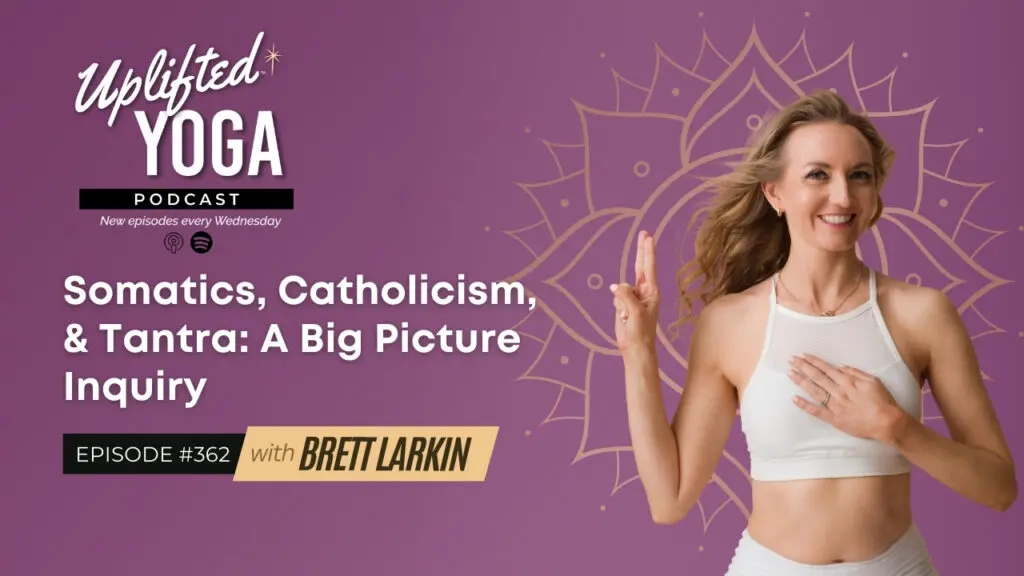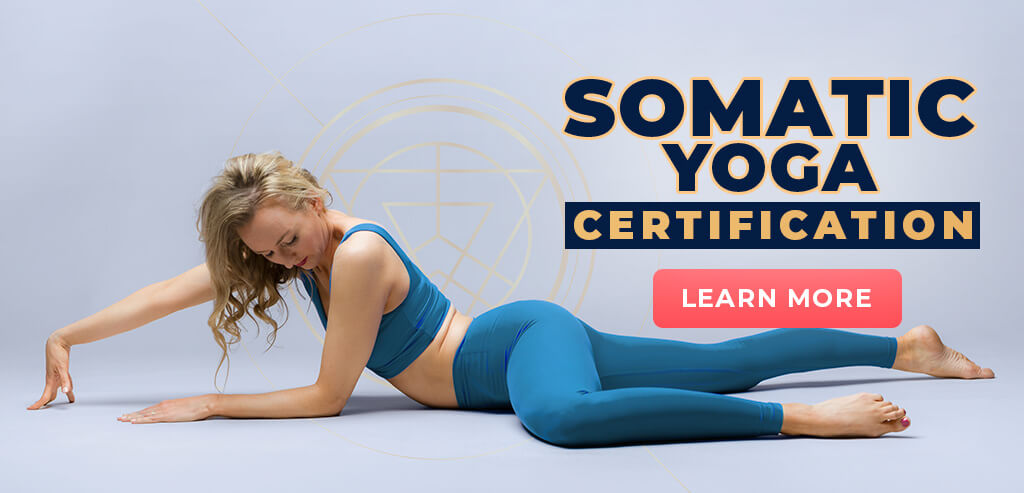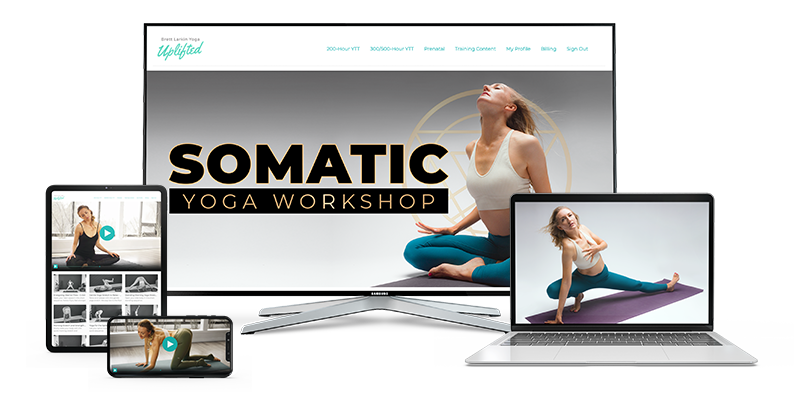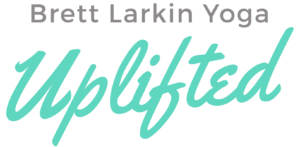
When did we get disconnected from the body? Today I want to explore the historical context of body-based spirituality. We’ll contrast traditional yoga’s focus on enlightenment with somatic yoga’s emphasis on healing and grounding. We’ll analyze how Catholicism and Tantra might be viewed as more embodied spiritual practices, compared to Protestantism and The 8 Limbs of yoga. Let’s nerd out on the significance of engaging the five senses in the healing process, the need for safe spaces in somatic practices, and the future potential of somatic work in personal healing and coaching.
Listen and learn:
🔹The cultural disconnection from the body and its historical roots.
🔹What Catholic Sacramental Theology and Tantric Philosophy have in common.
🔹How to leverage these ideas in your own healing process.
🎁 Get my FREE $67 Somatic Self Healing Workshop => https://www.brettlarkin.com/ffy
💫 My NEW Somatic Yoga Certification is now available => https://www.brettlarkin.com/somatic-yoga-certification/
FREE Practice: Easy Kundalini Yoga for Women | Kriya to be DIVINE LOVE EMBODIED
Relevant Blog: Understanding What is Divine Love: Key Insights and Perspectives
Relevant to Today’s Episode:
🔮 History of Yoga
✅ 200-hour Online Yoga Teacher Training
🎧 Also Listen to:
#285 – Is Yoga Enough…? with Dr. Jen Fraboni
#318 – What Is Somatic Yoga?
#330 – Somatic Yoga vs. Traditional Yoga: Breaking Down How 5 Poses Differ in your Yoga Practice
© 2025 Uplifted Yoga | BrettLarkin.com

FREE Embodied Yoga Workshop (usually $67) Somatic Techniques & Cord Cutting Ritual

Transcript:
Brett:
Hello, yoga family. So if you have been not living under a rock, you probably know that this idea of somatic yoga or embodiment work is really trending. I think we saw it trending in 2024 and it continues in 2025 and beyond. Let’s start over.
Hello, yoga family. If you are part of this community, you are probably aware that something called somatic yoga, embodiment work has been on the rise the past several years. What does all of this mean? Well, I have a podcast all about that. What is somatic yoga? I also have a podcast where I compare different yoga poses, like traditional yoga pose compared to the somatic version of that pose. So those could all be great episodes for you to check out.
Today, I wanted to talk a little bit about how as a culture we have become disassociated from the body. Like how did we end up as floating Zoom heads on a screen? Obviously the pandemic accelerated this process, but I think it’s a process that actually started several hundred years ago and we’re gonna look at Catholicism, Tantra, the Protestant lineage.
all sorts of different comparative religious studies to sort of see like when did the body get labeled as maybe evil or the body get taken out of spirituality and spiritual practices. So as a backdrop, somatic work and somatic yoga, one of the key ways that I differentiate it from traditional yoga is that it’s really engaging the five senses in order for you to deepen your awareness, release tension,
And the goals are very different. So in traditional yoga, the goal is enlightenment. The goal is moving your body so that you can then sit still for a long time. Shakti or Kundalini Shakti that lives at the base of your spine can run up your spinal column, Shishimnadi, to merge with Shiva, universal consciousness, which would be represented kind of at the top of the head or out in the universal field of awareness. So it’s literally a process.
actually of kind of disembodiment and leaving the physical body. The yogis thought the body had a lot of pesky urges, right? The body wants to eat, the body wants sex, the body wants to fidget. So a lot of the yogic practices that we see were for people who were either preparing for the next life or devoting themselves to basically life in a monastery to do these deep yogic practices that help them in many ways disassociate from the body.
Contrast this to what’s now emerging as somatic yoga, which is basically coming back to the tantric approach, which has been an approach I’ve taught in all my training since 2015, which is that the body is actually a vehicle for liberation and that when we meditate or raise energy, we’re doing that to, yes, maybe have this feeling or sense of being interconnected with everyone and everything.
But the purpose is then to bring that energy back down through the body, back down through the chakra system to reground that energy so that you can then go out and live like a genius in your own unique life.
If you’ve taken my 200 hour teacher training, you know, we talk about the importance of grounding in our meditation modules a lot. Most yoga schools I find completely overlook grounding, which is, which is too bad, right? Because most people, their energy is very up in their upper chakras because we live in the information age and then they’re meditating and they’re kind of getting maybe even more heady or spacey. So this grounding, the downward current is absolutely essential to cultivate.
So in somatic work, the purpose of the breath work and the postures isn’t about enlightenment, it’s about actually healing, self-healing, bringing the body back into balance, using an integrative mind-body approach to healing. And one of the key ways that it does that is by engaging the five senses.
If you’ve taken any of my somatic classes, you know touch is a huge part of that, the tactile awareness, right? So when you touch your own body, you increase proprioception, awareness of body position, awareness of where your body is in space. You help your brain actually remap that part of your body, which means that you might receive or interpret signals, including pain signals from an area of the body that’s not been mapped correctly or has gone offline podcast I have with Doc Gen Fit. talk a lot about the science of that.
We use the sense of sight, visual perception. If you do the somatic yoga teacher training with me, we talk about a lot of what I call exteroceptive, like grounding practices that are good for people who’ve experienced trauma where they keep the eyes open. Lots of exercises we can do with them where they track their eye movement to improve coordination and nervous system regulation. There’s some exercises we do with the finger.
and moving the fingertips, but lots of eye open to kind of orient and create safety.
If you’re a hardcore yogi, you’re probably really good at like closing your eyes and going inward. But something that we can practice in a somatic context is, okay, well, when we close our eyes and go inward, are we actually disassociating from the body and the here and now?
Is that a coping mechanism? So something we explore in that training is like, how can we help people have, it’s kind of like one foot in and one foot out, right? To be completely body aware, but also aware of where my body is in space, because it’s, need both of those things to actually feel safe in your environment.
the next sense would be sound, right? Auditory awareness. So whether that’s listening to the breath, practicing more vocal pranayama, audible pranayama. And then of course, actually emoting or doing vocal activation, sirenning on vowels. There’s a whole vocal activation module in the training as well, because most of us get trapped in one vocal register, which leads to one facial expression and the muscles in the face and jaw only really being used in one way. So when we’re able to…
create little more chaos in the different noises we’re making, it can open up new neural pathways in the brain.
Also, one of the fastest ways to move energy is to create sound. So if you want energy to move in a more profound, quick way, add sound. So a huge part of somatic yoga is actually trying to make sound from the gut or make sound from different body parts to emote, to express.
Next, let’s think about smell. Smell is a huge component of this. Many of you know that if you smell something in particular, it can like jog a memory and take you back instantly. I Proust’s whole book, right? He eats the Madeleine cookie, right? And it like takes him back to this moment in childhood. You have maybe experienced that. You smell your grandmother’s old perfume or you enter like a dusty beach house that was like the one you had as a child. And it’s like, boom, you’re back there.
So smells are so powerful and often when I’m somatic coaching with people, we’re doing a lot of work to conjure characters or energy textures or ideas and I’m really pulling and asking them to leverage all five senses.
in order to get the body involved in the healing process, because we all know now you can’t just heal intellectually talking about things. You actually have to, you know, feel to heal, which means you need to use, use your body, kind of go back into a physical state, which, depending what people have, have been through and need to work through, can, can feel scary, but actually can also feel quite pleasurable.
In the SOMATIC life coaching program, we work a lot with how can we help our clients or students create a safe space, a safe energetic space that’s personal to them, leveraging all five senses.
How can we leverage what feels good or what feels pleasurable as a way to move energy?
I truly believe with the right approach and in a safe space, healing can be fun. Healing can be pleasurable and that we actually heal faster when we tap into self nourishment and movement that feels soothing and pleasurable first.
The last sense is obviously taste. We don’t do a lot of eating in somatic yoga, but again, it’s con the idea here is that we’re conjuring all five senses. A lot of times in somatic coaching, I’m asking people what colors they’re seeing, what visuals we’re doing, a lot of personification work. Like if that emotion or feeling was an animal or was a color or was a smell, you know, how would it want to move? Would it want to move up? Would it want to move down? Would it want to move sideways? And in a group somatic class, you can leverage a lot of these same types of cues.
If we go back in history, or sticking with Western civilization for a moment, before the Protestant Reformation, I think the body was much more involved in the Christian faith and the…
way that people understood and experienced spirituality.
I think it’s interesting to look at or have an awareness of how Catholicism, for example, is a much more somatic religion compared to Protestantism, which came later.
If any of you have ever been to a Catholic mass, it is an incredibly physical experience. First of all, you kneel. It’s pretty unique. You’re kneeling as you pray. You get up, you sit down many, many times, you kneel, you stand up, you make the sign of the cross touching the body in the same places as where the Kundalini yogis said you had the vertical and horizontal orbit.
So in Kundalini, we have one orbit of energy moving up Sushimnanadi, down Ida Pingala in the vagus nerve, and then we have the heart orbit.
coming up the left arm down the right. So the in Catholic mass or Catholic prayer, you’re literally kind of touching those same energy points before they read the New Testament in Catholic mass. They’re also touching the forehead, touching the lips, touching the chest.
Then there’s the actual act of the Eucharist where you eat bread or consume wine.
The Catholic religion works with these sacraments, right? So we have baptism, water is poured over the body, symbolizing cleansing and rebirth and the sensation of the water on the skin marks a physical transformation. So it’s again, using the senses, the outside world as part of a spiritual experience.
the Eucharist, right? You’re literally eating the body of Christ and drinking.
The wine at confirmation, there’s an anointing of oil on the forehead. In the tantric tradition, we also see something called Shaktipad. Some of you mainly only might only be aware of Shaktipad. think it’s like an acupressure mat brand now, but it actually from the tantric lineage was like a teacher literally placing, I’ve had this done to me, a teacher or guru placing their hand on your head very similarly to transfer energy.
but traditionally this involved oil, touch, smell. It signified the sealing of the Holy Spirit and Catholicism, obviously.
In Tantra, the goal is to awaken higher states of consciousness and accelerate spiritual awakening for the person.
And that’s actually an important distinction we can double click into in Catholicism. The priest or the bishop is a channel for God’s grace, but the power ultimately is coming from God.
In Tantra, the guru or teacher in touching the student is directly awakening the student’s own inner energy, right? That Shakti initiating a spiritual evolution.
Reconciliation or confession is another one of the Catholic sacraments, actually involves speaking, sins out loud, so using the voice, and then hearing absolution and engaging in basically chanting, again, it’s prayer, but repeating Hail Mary’s, or again, actually physically doing something with the voice and the body.
The anointing of the sick is also again using oils, the priest anoints.
someone with oil for comfort, healing through touch.
marriage, you know, somewhat of a somatic experience. mean the couple expresses vows, you know, speaking out loud. There are rings that are exchanged, often they’re holding hands. There’s the wedding kiss. So again, there’s these outward embodied physical signs that something spiritual is happening is the idea.
So my only point here is if we look at different religions or we looked at Western civilization, the Catholic system, which is older than the Protestant system by many, many, many years, originally that sacramental system saw the body as an essential medium of grace. Whereas later, the Protestant traditions really emphasized more of like an internal spirituality.
If you’re familiar with the Protestant tradition, right? There’s not the oils and the eating of the bread and all of these.
rituals that involve, you know, stuff and things and, you know, someone needs to say the exact right words with the exact right, you know, things there. I mean, if you have attended a Catholic mass, you you see the process of the Eucharist and how detailed it is and how everything needs to be done in a certain way in a certain order.
So the Protestant tradition is saying, it’s a more symbolic interpretation. They don’t use the sacramental system in quite the same way, which I think is actually a system that.
is promoting that matter, stuff, or the body can convey divinity or divine realities.
So what’s interesting is both Catholic sacramental theology and tantric philosophy share this really fundamental similarity, is that both view the body as a conduit for spiritual transformation.
Now, they differ in their theological foundations and goals and methods for some of these things, but it’s interesting that we see that kind of somatic embodiment piece is shared.
So the Catholic view uses sacraments and these sacraments use physical elements, water, oil, bread, wine, touch, as actual means of transmitting divine grace. So the physical world is not seen as separate from God, but actually a vehicle for encountering God. And in the tantric view, the body itself, the body is an instrument of spiritual awakening. It’s not an obstacle as, you know, the traditional…
yoga practices that viewed the body as an obstacle to overcome once were. And Tantra’s teaching that Shakti, this divine energy, is present in the physical realm and that when we engage the body through rituals or mantra or breath work or meditation, one can achieve moksha or liberation.
So Catholicism has this flavor of sanctifying the body in order to bring it into participation with the divine, while tantra, the practices are more techniques for transforming consciousness.
Catholicism we have this huge embodiment concept which is that Christ actually incarnated as Jesus so God took on flesh which makes basically material reality a means of divine connection.
In tantra, the divine is immanent, the divine is seen in all things, including the body. So there’s no separation between the physical and the spiritual. So both of these traditions are truly, I would say embodied or somatic at their core.
What’s interesting too is if we look at the miracles that Jesus actually performed according to the Bible or the New Testament, some of the miracles he does through just his word alone, right? He just says something and it happens.
Like in the book of Matthew, Mark and Luke, there’s him healing this paralyzed man. And he just says, your sins are forgiven, get up, take your mat and walk. And the man is just, boom, he’s healed. know, Jesus, God just speaks it and it happens. But then there’s so many other instances where Jesus or God actually heals using the material world, using the physical elements or using touch.
In John 9, he heals a blind man using mud and saliva.
In Mark 7, he heals the deaf and the mute man, again, using saliva.
In Matthew 8, he heals Peter’s mother-in-law through touch. He touches her hand and then her fever leaves.
At one point a woman touches his cloak and suddenly she’s healed just by touching his cloak. And Jesus actually says, the power has gone out from me. Meaning that, you know, the hem of his cloak somehow through him or through like the material world somehow had a connection to make this all happen. Like the cloak had the power or the power flowed through the cloak.
Brett (28:40.408)
So it’s interesting, right, because it’s like if the idea of God or Jesus can heal through words alone, meaning just speaking, you know, why are there so many examples of him using the material world, using touch, using mud, using spit, using clothes?
Brett (29:20.408)
point here is that we’re seeing physical reality, basically matter stuff, as a vessel of divine power.
Brett (29:36.588)
this idea or this approach, whether it’s easier for you to grasp, you know, thinking about the tantric lineage or Catholicism is very different than what we see in a text like the Yoga Sutras, for example.
Brett (29:58.498)
That’s a totally different type of book. It’s about quieting the mind chatter and like a formula how to do that on your own.
how to act, what to do, but it’s not telling you like go, you know, make a tonic or ingest some bread or do these rituals or engage with the physical world or your body.
Brett (30:29.176)
to get any of these things. I mean, guess we have the one line, yoga is a comfortable, steady seat, so we have that, but that’s really it.
Brett (30:48.91)
So the overarching point or idea that is an invitation to consider is that, you know, over the years, right, that the body got taken out or the body and the physical world as a means to connect to the divine somewhat went missing. I think it went missing as yoga came West, as yoga was made more palatable to the West.
some of these, know, tantra was considered taboo. There’s so many incredible texts as part of the tantric lineage, but everyone just focuses on the Karma Sutra, right, which is like the one book that talks about sex and sexuality. So it was kind of seen as taboo.
Brett (31:36.066)
with the Protestant Reformation, know, the Protestants had a lot of concerns about, you know, they were worried about idolatry, right? Like if you’re using these oils and cups and all these rites and rituals, you know, at what point are you worshiping those things instead of properly worshiping God, which is a completely valid concern.
Brett (32:00.152)
But think somewhat the body and the physicality of how one perhaps worshipped changed.
and became more head oriented and less full body oriented.
Brett (32:17.324)
And think about us now in the information age where so many of us, most of us are working at a desk, most of us have access to more information than our great-great grandparents did in their entire lifetime in a single day. Like that’s how much information we consume on our smartphones and our mobile devices. So I really truly feel like an awareness of somatic work and principles.
Brett (32:43.15)
to get back into your physical body and using your body as a healing tool.
Brett (32:52.65)
is more needed than ever before. Yes, it’s fantastic if you can meditate or teach someone else to meditate.
But I truly believe the future is, it goes beyond that, right? It’s about how to get people actually in their body, leveraging the five senses like we talked about. Obviously, if that’s something you’re interested in going deeper into either for your own personal healing, trauma healing, or because you want to work as a somatic coach or teach somatic yoga classes, I would love, love, love to see you in either of my somatic trainings, the somatic yoga teacher training or the somatic.
in body yoga life coaching training.
Brett (33:35.938)
Thank you for entertaining some of these ideas on today’s podcast.
Brett (33:44.844)
I always love trying to zoom out and look at the big picture.
Brett (34:07.65)
or seeing if we can usher in new and deeper understandings when we look cross-culturally or compare different religions.
Brett (34:22.434)
Hopefully there’s an interesting nugget that you’re taking away or thinking about deeper from this episode. And thank you so much for being here all the way to the very end.
Brett (34:35.788)
Engage your senses today, feel fully in your body.
Brett (34:49.048)
Maybe just put your hand on your heart right now so at least you get that touch connection and from my heart to yours. Namaste.








